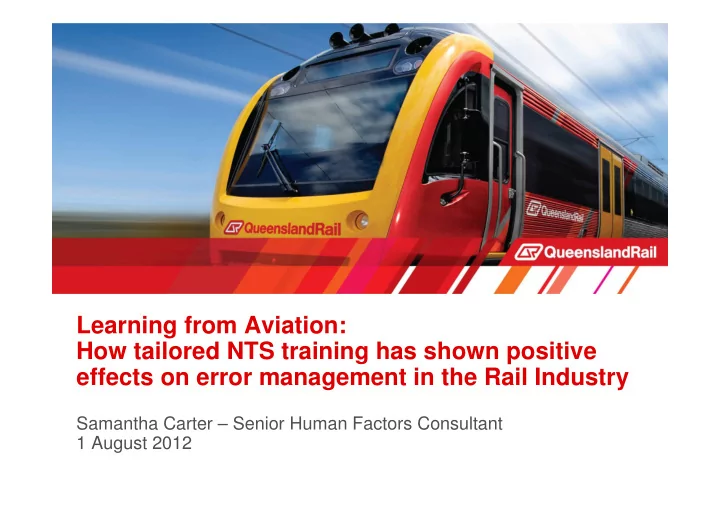

Learning from Aviation: How tailored NTS training has shown positive effects on error management in the Rail Industry Samantha Carter – Senior Human Factors Consultant 1 August 2012
RRM Rail Resource Management Drivers Guards N N Day 1 266 152 Day 2 250 139
Non-technical skills � Threat and Error Management � Situational Awareness � Leadership � Teamwork � Communication � Decision Making � Workload management
Core principles Peer facilitation Safety focus Course length Participants Joint training Classroom climate Feedback to organisation Assessment of learning National RRM Guidelines, 2007
Process Obtain Develop Implement Review Continual agreement program improvement -Present concept -Training Needs -Recruit and -Facilitation -Facilitator -Assess Analysis (TNA) select facilitators styles (360° ) development readiness -Tailor content -Train the trainer -Facilitator -Content updates -Agree on scope -Evaluation tools -Deliver training calibration -Roster plans -Administer sessions evaluation tools -Evaluation reports
Evaluation � Course Evaluation Forms � Attitude Surveys � Knowledge Tests � On-track Observations � Incident rates (SPAD) � LOSA results (CORS)
Signal Passed At Danger 101 � RRM: 13.71% drivers (first 12 months) had a SPAD � NO RRM: 26.32% drivers (first 12 months) had a SPAD � While the likelihood (of having a SPAD) has traditionally been higher for drivers within their first 12 months of driving, this may be reduced by RRM.
� Jump-seat observations - normal operations � Safety-targeted data collection tool � Joint management / union sponsorship � Voluntary participation � Anonymous and confidential data collection � Trusted data collection site - UQ � Feedback of results to drivers � 8 trusted and trained observers � Data verification ‘calibration’ sessions � Data-derived targets for enhancement
Threat and Error Management Threat Resolved/ Threat Managed Management Threat-linked Spontaneous Error Error Resolved/ Error Managed Management Undesired State Undesired State Incident / Resolved/ Management Accident Managed
Threats Threat Data CORS Round 1 (2005) CORS Round 2 (2008) CORS Round 3 (2011) LOSA (Archive) % of observations with 99% 99% 99% 97% Threat(s) Average Threats per 3.9 4.4 4.7 4.2 Observation Threats by Phase of Journey 53% Mid-section 46% Mid-section 43% Mid-section 40% Predeparture / 16% Approach 14% Approaching 12% At Platform Taxi Platform Platform 6% Approaching 30% Descent/ Appr / 15% At Platform 14% At Platform Platform Land Most Frequently Observed In-cab Events 27% Trackside Events 27% Trackside Events 30% Weather 25% Threats Trackside Events 22% In-cab Events17% Operational Issues 16% ATC 25% Passenger Events 18% Operational Issues 16% In-cab Events 12% Aircraft Threats 13% % Threats that are Managed 78% 89% 88% 90% % of Threats Leading to 17% 12% 8% 10% Error Most Frequently In-cab Events, Trackside Events, Radio Communication, Aircraft, Mismanaged Threats Radio Communication, In-cab Events, In-cab Events, ATC, Trackside Events Operational Issues Trackside Events Adverse Weather % of Undesired States 37% 36% 42% 30% linked to Mismanaged Threat(s)
Errors Error Data CORS Round 1 (2005) CORS Round 2 (2008) CORS Round 3 (2011) LOSA (Archive) % of observation with 75% 60% 74% 80% Error(s) Average Errors per 1.6 1.2 1.4 3.0 Observation Errors by Phase of 57% Mid-section 44% Mid-section 44% Mid-section 40% Descent/App/Land Journey 21% At Platform 22% At Platform 15% At Platform 30% Pre-departure/Taxi 13% Approach Platform 10% Approaching Platform 5% Approaching Platform Most Frequently 34% Procedural 42% Procedural 46% Train Management 50% Procedural Observed Errors 23% Train Management 27% Train Management 14% Procedural 33% Aircraft Handling 16% Train Handling 13% Train Handling 14% Train Handling 17% Communication % of Errors Leading 6% 2% 1% 6% to Additional Error % of Errors Leading 47% 44% 23% 19% to Undesired States Most Frequently Train Management Procedural Radio Communication Flight control errors Mismanaged Errors Station Start/Stop Prioritising Train Handling Automation Radio Communication Radio Communication System / Instr / Radio
CORS results Train Management Errors Errors trapped Average rate per journey Average rate per journey
Recommend
More recommend